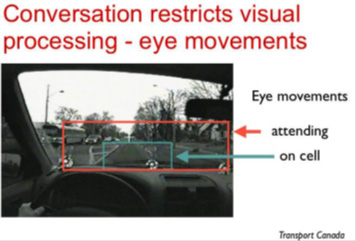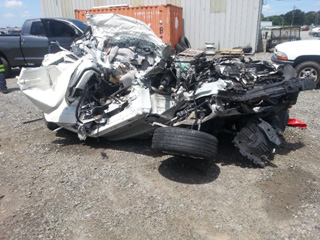|
Car fatalities in the first half of 2016 rose 10.4%, a steep increase following an uptick in fatalities in 2015. The rise in deaths raises fresh concerns over the use of technology, phones and distracted driving.
An estimated 21% or 1.2 million crashes in 2013 involved talking on handheld or hands-free cell phones. An estimated 6% of crashes (or 341,000) involved text messaging.
Research on the effects of distraction by cellular phones on driver performance consistently indicate that these devices significantly increase driver distraction and impair driver performance by producing manual, visual and cognitive impairments. The mental workload of cellular conversations restricts the eye movements necessary for adequate surveillance of the roadway. The brain of a driver processing a cellular conversation draws mental resources away from the driving and produces a deterioration in driving performance. Distracted drivers experience what researchers call inattention blindness, similar to that of tunnel vision. Drivers are looking out the windshield, but they do not process everything in the roadway environment that they must know to effectively monitor their surroundings, seek and identify potential hazards, and respond to unexpected situations. Even simple messages can produce dramatic decreases in attention to the roadway. One study reported even simple texts, such as “I will be there soon” took about 37 seconds to complete on average. During that time, 26 seconds were spent looking away from the roadway.
 Example eye movement patterns for attentive driver (no cellular phone conversation) and driver on hands-free cellular phone from an on-road eyetracking study. Hands-free Drivers are looking less to the periphery and they look less far down the roadway, producing slower or absent reactions to changes in speed of leading vehicles.
Example eye movement patterns for attentive driver (no cellular phone conversation) and driver on hands-free cellular phone from an on-road eyetracking study. Hands-free Drivers are looking less to the periphery and they look less far down the roadway, producing slower or absent reactions to changes in speed of leading vehicles.
A phone call in the minutes proceeding a crash increase the likelihood of a crash by over 400% regardless of whether the phone was used in a handheld or hands-free manner. This relative risk is similar to the hazard associated with driving with a blood alcohol level at the legal limit. In fact, simulator studies comparing drunk drivers to drivers using hands free cellular phones show that drunk drivers perform better. Distracted drivers brake more slowly and miss more safety critical events.
Research conducted on behalf of the Federal Motor Carrier Safety Administration indicates texting increases the risk of collision by 23 times in commercial trucks. An increase in risk by 23 times would mean texting increases risk almost six times as much as drunk driving.
Hands-free devices don’t eliminate cognitive distraction, but consumers are lulled into thinking they are safe using technology hands-free. As a result, permissive cellular phone laws and policies, allowing for some use of distracting devices (i.e., via hands-free), place drivers and others at risk. Full, enforced bans on the use of cellular phones are necessary to obtain better safety outcomes. The ban must be complete and include hands-free devices, must be accompanied by education, and must be enforced.
For more information: Contact Us |



 Example eye movement patterns for attentive driver (no cellular phone conversation) and driver on hands-free cellular phone from an on-road eyetracking study. Hands-free Drivers are looking less to the periphery and they look less far down the roadway, producing slower or absent reactions to changes in speed of leading vehicles.
Example eye movement patterns for attentive driver (no cellular phone conversation) and driver on hands-free cellular phone from an on-road eyetracking study. Hands-free Drivers are looking less to the periphery and they look less far down the roadway, producing slower or absent reactions to changes in speed of leading vehicles.